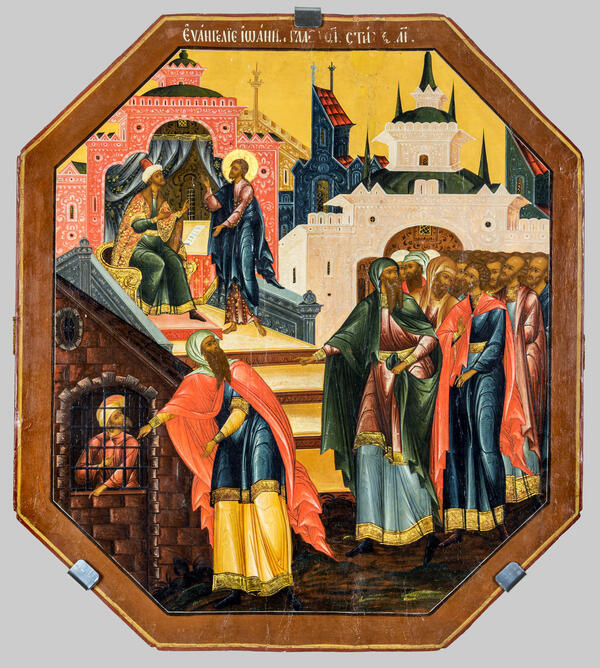Octangular icon ‘Jesus before Pilate. A scene from the Gospel of John’ was painted in the Sofonov Icon-Painting Workshop in the third quarter of the 19th century. The workshop created a large series of iconostases for customers from all over Russia (an iconostasis is a partition between the altar and the rest of the church decorated with a lot of icons). The icon ‘Jesus before Pilate’ also became part of an iconostasis.
The artists created a complex multi-figured composition typical for the Palekh style. The icon illustrates Chapter 19 of the Gospel of John. In the upper part of the composition, the Sofonovs depicted a scene with Jesus in front of the procurator Pilate: their meeting is described in Verse 11. High priests and ministers of the church are standing below: in the gospel, this happens in Verse 7. But instead of Jesus in a crown of thorns, the lower scene depicts an imprisoned Barabbas, which corresponds more to Chapter 15 of the Gospel of Mark or Chapter 23 of the Gospel of Luke. It is believed that the Palekh artists borrowed the iconography of Jesus before Pilate from European prints.
The icon is painted in the ‘podstarinniy’ (lit.: antique imitation) style, which became especially popular in the second half of the 19th century and was practiced in the Sofonov Workshop. It’s idea centered around the return to the old icon painting techniques. Artists deliberately abandoned excessive realism, making the background flatter and the paintings more graphic and strict.
In the icon “Jesus before Pilate”, the artists from the Sofonov Workshop used a rather sharp painting style full of contrasts of color, light, and shade. They achieved it by mixing in a lot of white paint (which was also typical of the Palekh icons of the second half of the 19th century). The artists used strokes of light paint matching the main color to make the figures look three-dimensional. The lightest areas are underlined with thin white stripes. The folds on the loose fabrics create the illusion of movement. The artists used dense colors and dark lines of different thickness to show the depth of the folds.
Despite the overall contrast of the icon, the faces still look soft. The greenish-brown underpaint (the first layer of color on the faces and hands of the saints in icon painting) is covered with layers of ocher with faint rouge shades. There are no excessive light accents. The lips of the saints are barely touched by vermilion-red hues. The artists applied the lightest strokes of white paint to the foreheads, tips, noses, and corners of the eyes of the characters.
Art critic Anatoly Bakushinsky said that the “old” Palekh icons had rather subtle color schemes. To a large extend, the imitated the frescoes from the Moscow cathedrals and ancient monasteries, which had darkened over time. The artists from the Sofonov Workshop used gold in the background and gaps sparingly. The shoulders and trimmings of clothes in the icon are decorated using assist gilding (strokes of leaf gold). Gold ornaments can also be seen on the robes of Jesus and Pontius Pilate, tablecloths, curtains, and the seat of the procurator.
The artists created a complex multi-figured composition typical for the Palekh style. The icon illustrates Chapter 19 of the Gospel of John. In the upper part of the composition, the Sofonovs depicted a scene with Jesus in front of the procurator Pilate: their meeting is described in Verse 11. High priests and ministers of the church are standing below: in the gospel, this happens in Verse 7. But instead of Jesus in a crown of thorns, the lower scene depicts an imprisoned Barabbas, which corresponds more to Chapter 15 of the Gospel of Mark or Chapter 23 of the Gospel of Luke. It is believed that the Palekh artists borrowed the iconography of Jesus before Pilate from European prints.
The icon is painted in the ‘podstarinniy’ (lit.: antique imitation) style, which became especially popular in the second half of the 19th century and was practiced in the Sofonov Workshop. It’s idea centered around the return to the old icon painting techniques. Artists deliberately abandoned excessive realism, making the background flatter and the paintings more graphic and strict.
In the icon “Jesus before Pilate”, the artists from the Sofonov Workshop used a rather sharp painting style full of contrasts of color, light, and shade. They achieved it by mixing in a lot of white paint (which was also typical of the Palekh icons of the second half of the 19th century). The artists used strokes of light paint matching the main color to make the figures look three-dimensional. The lightest areas are underlined with thin white stripes. The folds on the loose fabrics create the illusion of movement. The artists used dense colors and dark lines of different thickness to show the depth of the folds.
Despite the overall contrast of the icon, the faces still look soft. The greenish-brown underpaint (the first layer of color on the faces and hands of the saints in icon painting) is covered with layers of ocher with faint rouge shades. There are no excessive light accents. The lips of the saints are barely touched by vermilion-red hues. The artists applied the lightest strokes of white paint to the foreheads, tips, noses, and corners of the eyes of the characters.
Art critic Anatoly Bakushinsky said that the “old” Palekh icons had rather subtle color schemes. To a large extend, the imitated the frescoes from the Moscow cathedrals and ancient monasteries, which had darkened over time. The artists from the Sofonov Workshop used gold in the background and gaps sparingly. The shoulders and trimmings of clothes in the icon are decorated using assist gilding (strokes of leaf gold). Gold ornaments can also be seen on the robes of Jesus and Pontius Pilate, tablecloths, curtains, and the seat of the procurator.



